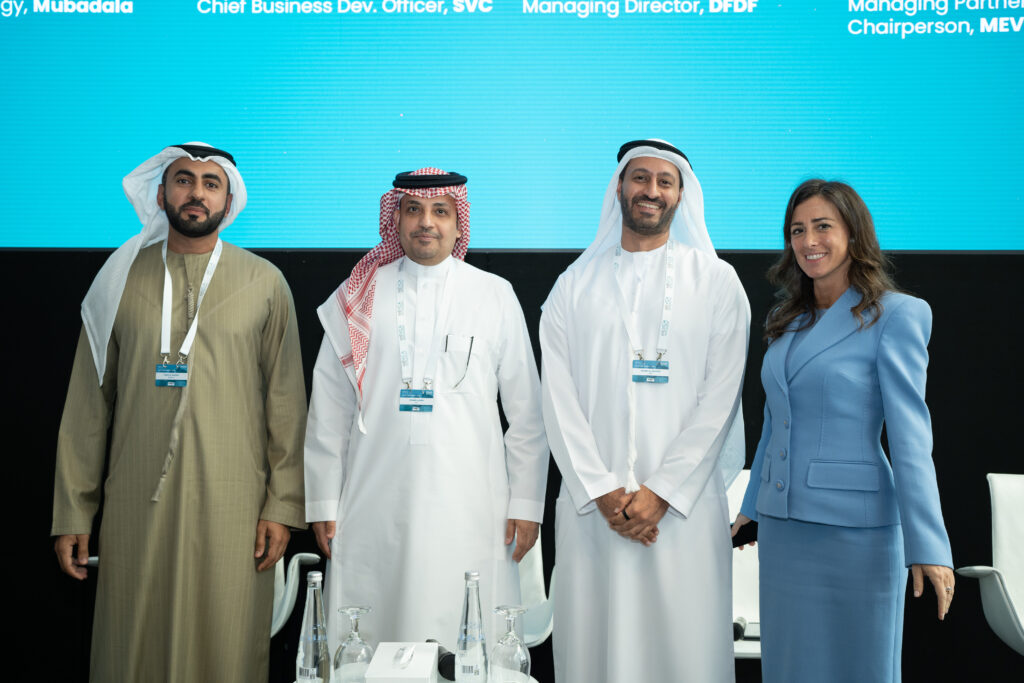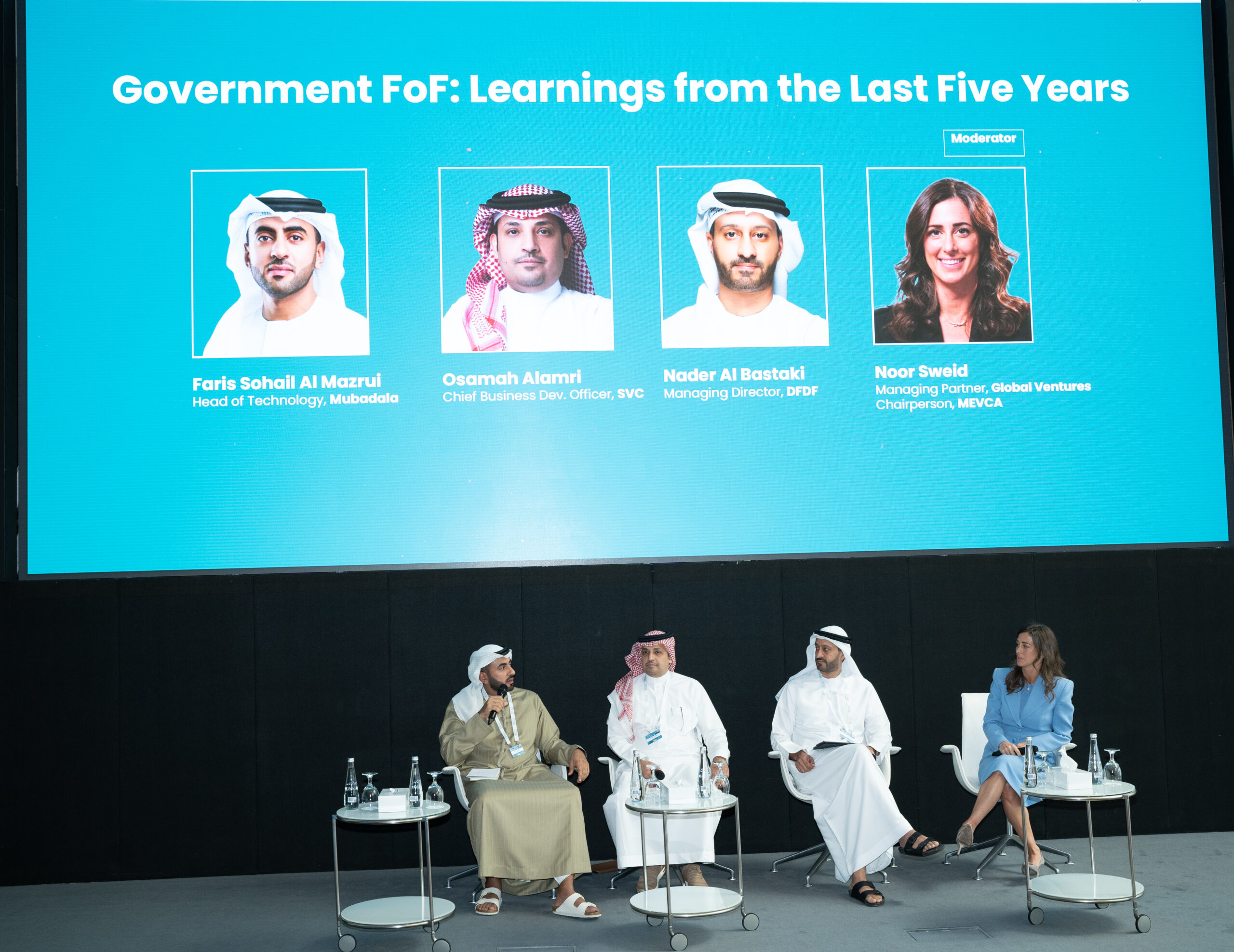The Middle East’s venture capital ecosystem has undergone a shift over the past five years. Once characterized by capital outflows to global markets, today, the region has become a magnet for investment, talent, and innovation. Government-backed fund of funds have played a crucial role in shaping this transformation, deploying capital into both funds and startups to foster long-term economic growth.
This evolution was the focus of a panel discussion at the Middle East Venture Capital Association (MEVCA) Investors Summit, held on 30 January 2025 at Abu Dhabi Global Market (ADGM), UAE. The discussion brought together industry leaders: Nader Albastaki (Managing Director, DFDF), Osama Alamri (Chief Business Development Officer, SVC), and Faris Al Mazrui (Head of Ventures & Growth, Mubadala), with Noor Sweid (Founder & Managing Partner, Global Ventures) moderating the conversation.

The Shift to Investing Locally
Seven years ago, Middle Eastern sovereign wealth funds primarily looked outward, deploying capital into global markets rather than fostering innovation at home. Today, the narrative has flipped.
Faris Al Mazrui highlighted that in 2010, Mubadala faced the challenge of attracting partners and investors to the region. Now, the opposite is true—global investors and funds are setting up offices in the UAE, drawn by the region’s long-term, strategic economic planning, favorable policies, and a thriving startup ecosystem.
This shift is evident in funding patterns:
- A significant portion of capital deployed into MENA startups now comes from international investors, reversing historical trends where local capital largely flowed outward.
- Dubai and Saudi Arabia have become talent magnets, driven by progressive regulatory environments, a growing tech ecosystem, and increased exits that validate investor confidence.
Saudi Arabia: A Five-Year Transformation
Reflecting on Saudi Arabia’s journey, Osama Alamri noted that just five years ago, the country’s venture ecosystem was in its infancy. Fast forward to today, and Saudi VC activity accounts for the majority share of all MENA venture investments.
What triggered this rapid growth?
- Vision 2030’s initiatives provided strong government backing for startups, fostering entrepreneurship and incentivizing private sector investment.
- Regulatory reforms played a critical role in streamlining business operations, making it easier for startups to thrive.
- Perhaps the most surprising development: the speed of exits. Successful IPOs (e.g., Jahez) and unicorns (e.g., Tamara) created a FOMO effect, drawing in previously hesitant investors, particularly family offices that traditionally favored real estate.
This growing trust in startups as a viable asset class is critical, but education remains key—fund managers are working to help investors understand risk, advising them to allocate 10-15% of their portfolio to venture capital while ensuring government co-investment provides a de-risking mechanism.
Dubai’s Competitive Edge & The Role of Government
Dubai has long been a hub for innovation and investment, but what continues to make it an attractive destination for founders and capital?
Nader Albastaki, representing DFDF, emphasized that while Dubai’s ecosystem is largely privately led, the government plays a crucial complementary role by:
- Providing strategic fiscal support to drive innovation, in alignment with federal economic strategies like D33.
- Creating an environment conducive to collaboration, as seen in major exits like Talabat’s listing and the continued influx of top-tier founders and funds.
- Supporting community building initiatives, such as the UAE President’s recent declaration of 2024 as the “Year of the Community”, further solidifying Dubai’s efforts for collective building and supporting innovation.
For DFDF, success is not just about capital deployment but also about measuring the broader economic impact of its investments—how they attract further capital, generate jobs, and contribute to ecosystem maturity.
Lessons from Global Investment Trends
The conversation also touched on international investment strategies and what MENA-based fund managers can learn from global markets.
Faris Al Mazrui shared insights from Mubadala’s experience investing abroad:
- The most successful fund managers have lean, highly focused teams and avoid the inefficiencies of over-hiring.
- Deployment strategy matters—the best managers make two or three excellent investment decisions per year rather than chasing volume.
- A deep understanding of public markets is crucial, even for private investors, to better gauge valuations and market shifts.
Meanwhile, Osama Alamri emphasized that fund managers in MENA must go beyond simply deploying capital. The next frontier? Adding real value to founders through:
- Venture building, acceleration, and ecosystem support.
- Helping startups scale beyond their home markets—particularly crucial for Saudi startups looking to expand regionally.
The Missing Middle: Series B Funding & Ecosystem Gaps
A recurring theme in the discussion was the Series B funding gap in MENA. Startups struggle to secure $20M+ growth-stage tickets, creating a bottleneck for scaling companies.
Noor Sweid pointed out a striking $950M gap in Series B funding across the region. Bridging this requires more conviction from institutional investors in local fund managers, ensuring capital flows efficiently across the entire venture stack.
According to Nader Albastaki, DFDF sees itself as part of this capital stack strategy—not just as a funder, but as a cohesive force ensuring capital layers complement one another, whether through venture funds, direct investments, or government-supported initiatives.
The Next Five Years: A Maturing Ecosystem
Looking ahead, what does success look like?
Faris Al Mazrui envisions a future where the region doesn’t just attract capital but becomes a global innovation magnet—a place where top founders don’t have to be in Silicon Valley to build world-class companies.
Osama Alamri expects to see:
- More sector-focused funds emerging, targeting deeptech, AI, biotech, and other strategic industries.
- A stronger emphasis on early-stage capital, addressing persistent gaps in pre-seed and seed funding.
The underlying message was clear: while MENA’s venture ecosystem has made significant strides, there’s still work to be done—particularly in ensuring continuity of capital, fostering deep sector expertise, and creating a self-sustaining cycle of innovation and investment.
Conclusion: The Future of Government Fund of Funds in MENA
The past five years have set the stage for a more mature, globally connected, and resilient VC ecosystem in MENA. Government-backed funds like DFDF, SVC, and Mubadala have played a pivotal role in this transformation, catalyzing capital flows, supporting founders, and shaping regulatory environments that empower innovation.
As the region looks forward, the focus will be on filling capital gaps, driving sector specialization, and reinforcing MENA’s position as a hub for the next wave of global technology leaders.
With strong public-private collaboration and a long-term investment mindset, MENA is no longer just a capital exporter—it is a region where world-class startups can thrive, scale, and succeed.


